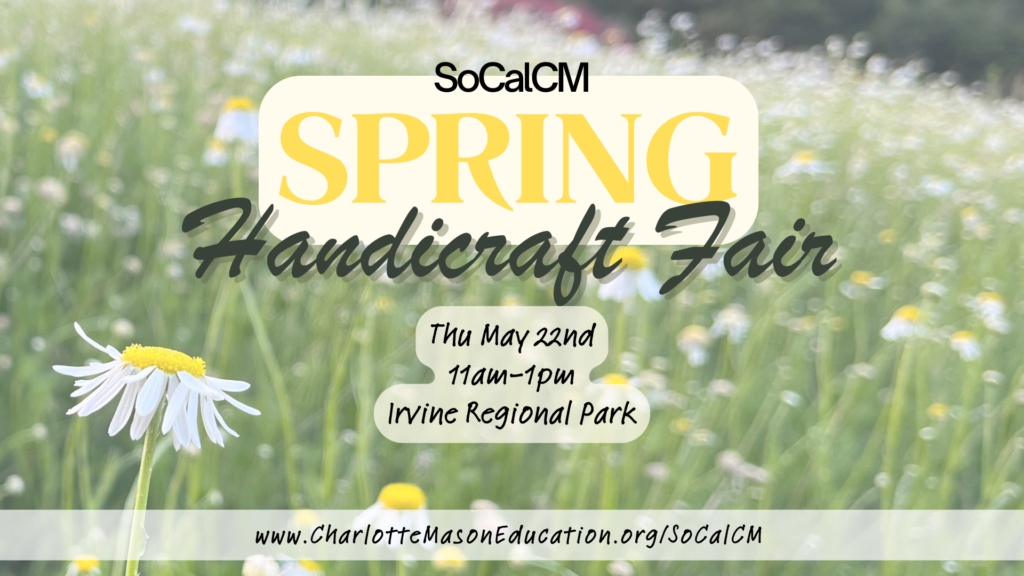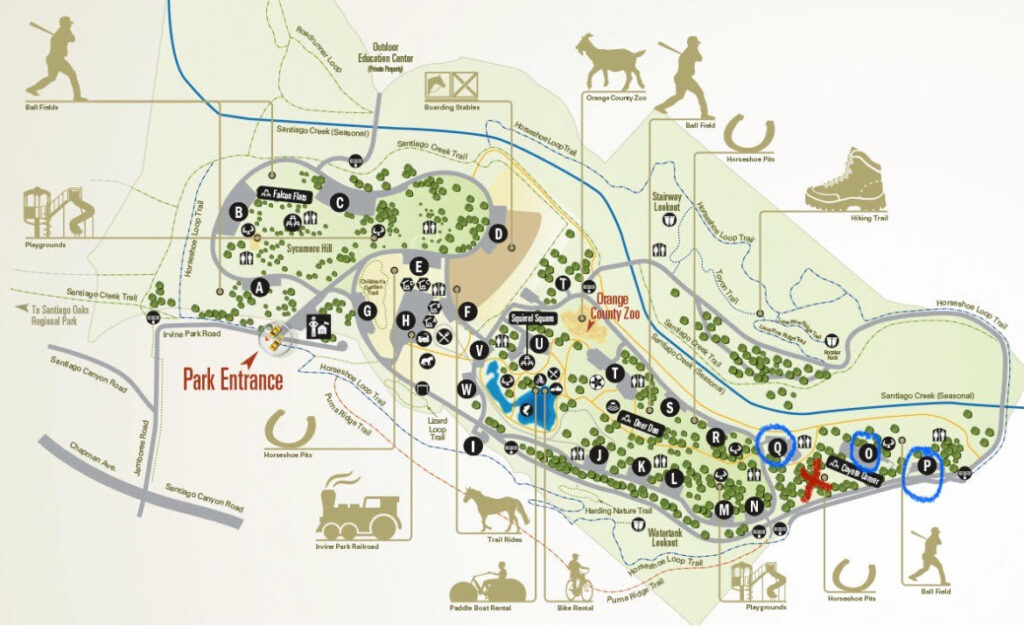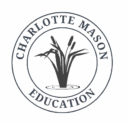

A celebration of skill, beauty, and craftsmanship in the Southern California Charlotte Mason community.
Date: Thursday, May 22, 2025
Location: 1 Irvine Park Rd, Orange, CA 92869 (next to Coyote Corner)
Time: Set-up begins at 10:30 AM
- Free to Attend & Shop (No registration required)
- Selling is reserved for students from families intentionally pursuing a Charlotte Mason education. (Registration required to sell)
- In Case of Rain or Park Closure: Every attempt will be made to reschedule. Any updates will be posted in our Facebook Group. Due to park permits, fees, insurance, and other costs incurred, refunds will not be issued.
(Early bird: $10 per family, $15 after Dec. 5)
What is the Handicraft Fair?
The SoCalCM Handicraft Fair is a bi-annual market day where Charlotte Mason students showcase and sell their handmade handicrafts. It’s an opportunity to celebrate the beauty of meaningful work, support young artisans, and enjoy a day of community.
What is a Handicraft?
A handicraft, according to Charlotte Mason and the broader P.N.E.U. philosophy, is a practical, meaningful, and carefully executed craft that cultivates skill, patience, and appreciation for beauty. It is not a frivolous or disposable activity (what Mason called “futilities” like stick-and-pea figures or paper mats) but rather a life skill that enhances a child’s ability to create with their hands in a way that has purpose and value.
Key Principles of Handicrafts in the Charlotte Mason Method
- Usefulness – The craft should result in something worthwhile (e.g., knitting a scarf, carving a useful object).
- Quality over Quantity – Children should be taught carefully and slowly so that their work is done well. Sloppy or rushed work should not be accepted.
- Age-Appropriate Skills – The task should be within the child’s ability while still requiring concentration and effort.
- Aesthetic Value – The craft should train the child’s eye and hand in creating something beautiful.
- Hand-Eye Coordination – Handicrafts refine motor skills, developing dexterity, control, and precision.
- Patience and Perseverance – Unlike quick crafts, true handicrafts require dedication over time.
Examples of Charlotte Mason-Approved Handicrafts
These are handicrafts specifically mentioned by Charlotte Mason who lived in the late 19th, early 20th centuries.
For young children (under 9):
Chair Caning – The process of weaving thin strips of rattan or reed into a wooden chair frame. Since furniture was repaired rather than replaced, this skill was a practical way to extend the life of household items, teaching both patience and craftsmanship.
Basket Work – Using natural, locally available materials like willow, reeds, or rushes, children wove small baskets for carrying books, gathering vegetables, or storing household items. Basket weaving was widely practiced in rural households, making it a valuable, real-world skill.
Smyrna Rugs – A type of rug-making involving knotting yarn into a backing material, similar to modern latch-hooking. Children learned to create decorative, durable rugs, using patterns and colors to develop design skills.
Japanese Curtains – Likely referring to decorative bamboo or fabric curtains made with woven strips, beads, or embroidery. This craft introduced children to textile arts and pattern-making, common in late 19th-century homes.
Carving in Cork – A softer, more manageable alternative to wood carving, cork was used to create small decorative objects. Since cork was lightweight and easy to shape, it allowed children to practice carving skills without the danger of sharp woodworking tools.
Samplers on Coarse Canvas – Before learning finer embroidery, children practiced stitches on a stiff, open-weave fabric. These samplers included alphabets, decorative borders, or simple motifs, developing both motor skills and patience.
Easy Needlework – Simple sewing projects such as hemming handkerchiefs, stitching small bags, or basic embroidery. This prepared children for more advanced sewing skills, ensuring they could mend and create practical household items.
Knitting (Big Needles and Wool) – Young children started knitting with large wooden needles and thick wool, making projects like scarves, doll blankets, or simple squares. Knitting was a fundamental household skill, helping children develop rhythm, concentration, and dexterity.
Handicrafts as an Educational Tool
- Connection to Nature & Art – Charlotte Mason’s philosophy emphasized how crafts relate to nature, history, and artistic expression. For example, a child might press flowers and use them to create botanical prints after studying local plant life or embroider a simple landscape scene after spending time observing nature.
- Training in Thought & Skill – Mrs. Steinthal’s P.N.E.U. lecture emphasized that handicrafts are not just about the hands, but about training the mind to visualize and execute a project step by step.
- A Joyful & Meaningful Activity – Many homeschooling parents following Mason’s method have found that handicrafts are not just part of “school time” but something children continue on their own for enjoyment, fostering lifelong creative skills.
Why Handicrafts Matter in Education
Charlotte Mason viewed the human hand as an exquisite instrument capable of learning delicate, skillful movements. She hoped to revive an appreciation for fine workmanship and the dignity of creating something well, whether through apprenticeships, trades, or homemaking skills.
At its heart, a true handicraft is not just an activity—it is a discipline that teaches a child to be a capable, skillful, and creative individual.
Again we know that the human hand hand is a wonderful and exquisite instrument to be used in a hundred movements exacting delicacy, direction and force; every such movement is a cause of joy as it leads to the pleasure of execution and the triumph of success. We begin to understand this and make some efforts to train the young in the deft handling of tools and the practice of handicrafts. Some day perhaps, we shall see apprenticeship to trades revived and good and beautiful work enforced. In so far, we are laying ourselves out to secure that each shall “live his life”; and that, not at his neighbor’s expense; because, so wonderful is the economy of the world that when a man really lives his life he benefits his neighbor as well as himself; we all thrive in the well being of each.
~Volume 6, Towards a Philosophy of Education p. 328
Additional Examples of Handicrafts:
Fiber Arts – Knitting, embroidery, macramé
Fine Arts – Painting, calligraphy, sculpture
Wood & Metal Work – Carving, woodburning, carpentry
Paper Crafts – Quilling, paper sloyd
Jewelry & Decorative Arts – Beadwork, flower arranging
Traditional Crafts – Baking, pottery, leather work
This is in no way an exhaustive list of handicrafts, more ideas and discussion on the topic can be found on the AmblesideOnline Handicraft Forum
How to Participate as a Seller
Selling is exclusively for students from families intentionally pursuing a Charlotte Mason education.
1️⃣ Register Your Booth
- $10 per selling family ($15 after May. 10th)
- Register & pay online
- No refunds if canceled due to weather/unforeseen circumstances
2️⃣ Set Up Your Shop
- Arrive no earlier than 10:30 AM
- Bring a small table or mat for display
- Have cash or change for purchases
- Pricing and sales are up to the student
3️⃣ Market & Sell!
- Engage with customers
- Feel free to barter/trade
- Take pride in your work & have fun!
What to Expect as a Guest
- Unique, one-of-a-kind handicrafts made by local Charlotte Mason students
- A welcoming, family-friendly environment
- Handmade treats & food items (varies per fair)
- A relaxed, festival-like atmosphere
Who can attend? Everyone! Bring family, friends, neighbors, and church members. The more, the merrier! 🎉
📌 FAQs
Can my kids sell anything they want?
Items must be handmade by the student. No reselling.
Can we sell used books?
Yes! Parents may bring gently used Charlotte Mason books & curriculum to sell in their child’s booth.
Can kids bring/play with toy weapons?
Yes, but they must be used safely. Misuse will result in removal.
Will someone supervise my children?
No. Parents are fully responsible for their children.
Can parents promote their businesses?
You may place small business cards or a sign at your child’s booth, but no product sales by parents—this event is for student artisans!
📍 Location & Parking
1 Irvine Park Rd, Orange, CA 92869
Park in Lots Q, O, or P
Set-up begins at 10:30 AM

Red “X” marks the setup area.
📢 Stay Connected!
🔹 #socalcmhandicraftfair
📌 @socal.cm
🔗 Facebook Group (Link to for updates & discussion)
📩 Questions? Contact the event coordinator: naomi@charlottemasoneducation.org
(Early bird: $10 per family, $15 after Dec. 5)

